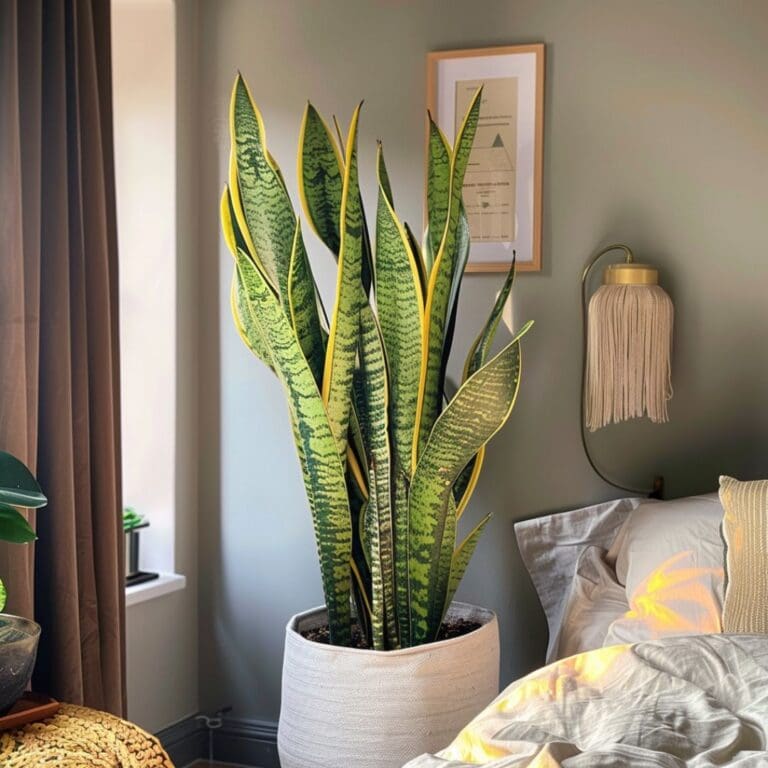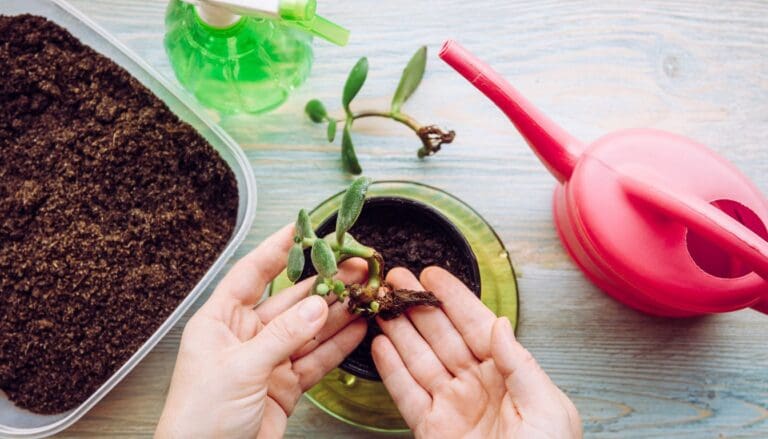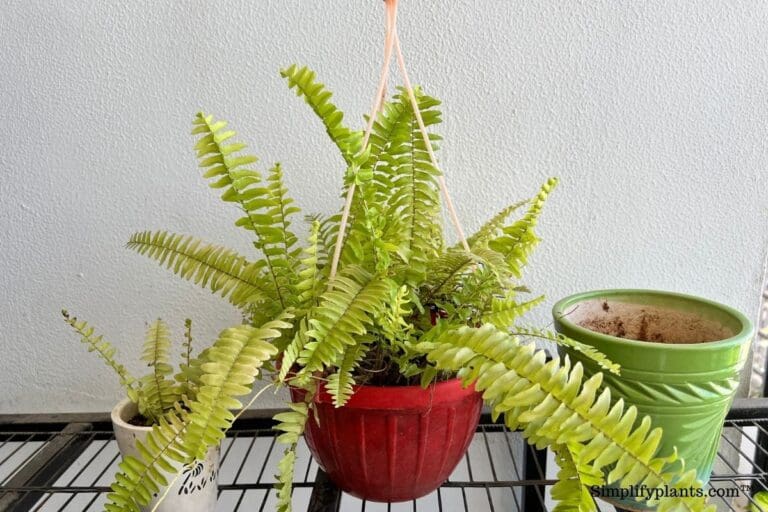Can English Ivy Grow Outdoors? (7 Crucial Factors To Consider)
English ivy plants are trailing plants that beautify any space. They are excellent ground covers with heart-shaped leaves in various colors. English ivy grows as houseplants, and many wonder whether it can grow outdoors.
English ivy grows well outdoors in partial shade to full sun. The green variants can handle shade, but the variegated ones need more sunlight. English ivy will need protection from frost and during intense hot summers. Also, never plant them directly in the ground as they can get evasive.
Before growing your English ivy outdoors, consider the sunlight, temperature, humidity levels, etc. In this article, you will learn everything you need to know to grow your English Ivy outdoors.

Please note: Simplify Plants is reader-supported. Some links in the post are affiliate links and I get a commission from purchases made through links in the post.
Can you grow English ivy outdoors?
English ivy plants are popular houseplants grown in hanging baskets throughout the US.
But there is more to it.
You can grow these beauties outside your homes to beautify the outdoors.
English ivy plants grow outdoors because the vines can decorate fences and walls.
They grow as dense cover in areas with no turf grasses in gardens.
When they grow outdoors, they can reach a massive height of up to 100 feet.
If the conditions of your region are suitable for the plant, they will thrive.
English ivy is popular because it can grow in various soil and weather conditions.
The variegated ones will need more sunlight than the green ones to maintain their colors.
But, if the region has hot summers, you will need to give them some shade.
These plants can tolerate winters outdoors but not frost and frosty winds.
So in such conditions, you might need to shift them to a more protected spot.
Factors that affect the growth of English ivy outside
Before moving your English ivy outside, analyze the environmental conditions.
Move the plant only if the conditions match its needs.
If not, your plant can face serious damage or can even die.
Certain factors like humidity, sunlight exposure, and watering are easier to regulate indoors.
But tricky to track outdoors, so you must understand those to avoid any mistakes.
Now let us study the different requirements of your English ivy outdoors:
1. Light
Light is among the most important elements of nature that a plant needs for growth.
Light allows them to photosynthesize, giving them the energy to live and grow.
English ivy does well in a variety of light settings.
It can grow in full shade to full sun depending upon the variant of the ivy and the region’s weather.
Your English ivy plant can tolerate full sunlight in colder climates or winter.
But you need to give it some shade during hot summers.
The green variants do fine in indirect light or partial sun.
But the variegated ones will need more sunlight.
Place your ivy at a spot that receives 4-5 hours of full sun daily and stays protected from the afternoon sun.
They can grow under full shade, but the growth rate will be slower in that case.
Can English ivy tolerate direct sunlight?
English ivy plant grows best under indirect or partial sunlight for up to 3-4 hours.
Direct sunlight for long hours can scorch the leaves in areas with hot summers.
The leaves will develop brown and yellow spots and become crispy and dry.
Choose a spot outside that shades the plant from the afternoon sun and provides mild morning sunlight.
2. Temperature

The ideal temperature needed for English ivy is between 70-90°F.
They are one of the hardiest cold tolerant plants.
Some variants of ivy grown in the northern landscapes can experience temperatures as low as -10°F.
But, note that though they can tolerate cold, it is best to protect them if your area receives extreme harsh cold winds and hard frost.
In such cases, you should move your ivy indoors or to a spot with some shade or protection against it.
English ivy plants do not go entirely dormant in the winter, but their growth rate reduces.
Protect them from harsh winds as they may disfigure them and put them under stress.
You can mulch the soil or cover it with dried leaves, twigs, etc., during winters to keep the plant warm.
What temperature can English ivy tolerate?
English ivy grows best in areas within 70-90°F.
But, they can tolerate temperatures as low as 50°F.
In such cold weather, its growth may reduce and show signs of stress.
English ivy is prone to injury in very low temperatures.
3. Watering
English ivy plant does not like staying in a pool of water at any time.
They enjoy slightly moist soil.
These plants are sensitive to overwatering, so watch out for that.
During winters, when the evaporation rates are lower and the plant is less active, you must cut down on watering as they become prone to root rot.
Before watering, let the top 2 inches of the soil dry completely.
When you grow the plant outside, always check the soil before watering.
During summer, keep the soil evenly moist.
And during winters, let it dry off between watering to reduce the chances of overwatering.
Also read: How to water an English ivy?
How often should I water my outdoor English Ivy?
How often you water your outdoor ivy is subjective.
Watering regulation and frequency depend on weather, temperature, light intensity, rainfall, humidity, etc.
But, remember the rule of thumb: to water the plant only when you see the soil’s top layer has dried.
If unsure, using a moisture meter is a great way to ensure your ivy needs water.
4. Wind
English ivy needs protection from strong wind.
Its delicate leaves cannot withstand all that force!
So when you grow them outdoors, choose a spot that doesn’t receive strong gusts of winds.
Harsh wind can damage this plant.
The plant can detach from the ground during storms or strong winds and break branches.
So if you live in windy areas, you should keep this in mind.
But, these plants face no issues in areas with an average wind.
5. Humidity

Humidity is essential when growing houseplants as it helps them stay hydrated.
Regulating the humidity is easier indoors with humidifiers or pebble trays.
But outdoors, it gets a little tricky.
English ivy does not demand very high humidity levels.
They can thrive in humidity levels around 40-50%.
If you live in an area where the air is dry, you need to look for ways to raise humidity.
Unlike indoors, you cannot use humidifiers or pebble trays outside.
English ivy plants enjoy getting misted.
So in summer, mist them to boost the humidity and keep their leaves free of dust and pest.
Can low humidity hamper the growth of my English ivy?
English ivy needs at least around 40% humidity around them.
Though they can tolerate lower humidity, their growth will get affected.
The growth will decrease, and the leaves might get discolored.
If your ivy is outdoors in dry conditions, mist it during summer.
Or, plant them near a fountain or any space with constant humidity.
6. Soil
Whether you grow English ivy indoors or outdoors, use light and well-draining soil that lets the roots breathe.
Ivy does not like tight, clumpy soil that holds a lot of water.
Adding compost and other organic elements like crushed charcoal improve the soil structure.
These keep the soil loose and allow oxygen to circulate in the soil.
Since English ivy is sensitive to overwatering, add perlite and sand to the soil.
This will improve the drainage.
What nutrition will be good for English ivy outdoors?
English ivy plants are not too finicky when it comes to fertilization and can grow without them.
But, if you want your ivy to have healthy and grow fast, adding nutrients is helpful for the plant.
You can feed your English ivy in the growing season with a balanced NPK 20:20:20 liquid fertilizer.
You can also add a slow-release fertilizer once in March and once in September.
7. Pests and diseases

Plants outdoors are more prone to pests and diseases than the ones grown indoors.
English ivy is a hardy plant resistant to most pest infestations.
But, mealybugs, spider mites, aphids, and diseases like leaf spots can affect your ivy.
Start the treatment as soon as you notice signs of pest infestation, as they spread fast and can kill your plant.
How to prevent pest infestations outdoors?
The first thing to do is to take care of the plant.
Pest infestations occur due to wet soil, damp air, high humidity, low light, dusty leaves, and so on.
Do not neglect those and provide all the favorable conditions to your English Ivy.
And since your plant is outdoors, ensure the leaves are clean and dust-free.
Avoid watering the leaves every time you water the plant.
Wet leaves attract pests.
In case of any infestation, wash the leaves with a strong hose to clear away the pests.
Trim off the heavily infested parts and spray horticulture oil or Neem oil.
How do you care for outdoor English ivy?
You can make your English ivy thrive outside with the following knowledge.
- Find a spot that receives full sunlight for 3-4 hours and remains under shade from the afternoon sun.
- Your English ivy enjoys average humidity. So if you live in a dry area, do not forget to mist your ivy daily in summer. This will also keep the leaves clean.
- The region must have a favorable temperature for the ivy. If your region experiences harsh cold, protect the ivy with a cover or move it indoors.
- If the region has hot summers, do not expose the plant to the afternoon sun as that may cause sunburn.
- The soil must be light and drain water well. Do not overwater your ivy. Always check the soil before watering.
- Spray your ivy with a Neem oil solution every month to repel pests and bugs.
- Don’t keep the ivy in a spot with strong gusts of wind.
- Fertilize your English ivy during the growing season.
- Mulch the soil to keep it warm during winters.
- Prune your English ivy whenever you see it growing out of shape. This will also encourage bushy growth.
- Grow them in pots instead of ground to keep the growth in control and to move it indoors if needed.
How to move the indoor English ivy outside?

Plants, like humans, do not like abrupt and sudden changes.
Make gradual changes if you intend to move your English ivy outside from indoors.
If your plant dwells indoors for a long time, and you move it outside one fine day, it will get shocked.
And that might affect its growth and health.
I want to share some things I followed while moving my English Ivy outdoors.
These will help your ivy adjust to the changes.
- First, select an ideal spot for the ivy after considering the above-discussed requirements.
- Keep your English ivy in a clay or terracotta pot instead of plastic, metal, or ceramic pots. The latter are not porous and tend to heat up fast under full sun.
- Next, move the ivy outside and keep it in partial sun for 3-4 hours. Move it back to the house. Follow this cycle for a week.
- If the plant reacts well to this, increase the duration and follow it for another week.
- Keep increasing the duration until you can leave your ivy outside for the entire day.
- If you notice any damage or signs of stress, move the plant inside and try again after a few days.
Final words
Growing English ivy plants outdoors is not uncommon. You can do it as long as the conditions are suitable. If you experience cold winters, grow the ivy in a pot so you can move it inside when needed.
Before you move your ivy outside, check the conditions. The sunlight intensity, temperature, and humidity should not be unfavorable. Choose a spot that doesn’t get too much wind. And don’t neglect the plant because you moved it outside.
Reference: Researchgate, University of Tennessee, Mississippi State University, Central Florida Research and Education Center, U.S. DEPARTMENT OF AGRICULTURE.
Recommended Garden Supplies
| Product Image | Our Recommended Gardening Supplies | Check Offers! |
|---|---|---|
Top Top
Top
Top
Top
Top
Top
Top
Top | rePotme Houseplant and Tropical Classic Potting Soil Mix | Check Offer On Amazon |
 Top
Top
Top
Top
Top
Top
Top
Top | Espoma Organic Indoor Plant Food | Check Offer On Amazon |
 Top
Top
Top
Top
Top
Top
Top
Top | GooingTop LED Grow Light 6000K Full Spectrum Clip Plant Growing Lamp | Check Offer On Amazon |
 Top
Top
Top
Top
Top
Top
Top
Top | Soil Moisture Meter | Check Offer On Amazon |
 Top
Top
Top
Top
Top
Top
Top
Top | Govee Hygrometer Thermometer, Bluetooth Enabled! | Check Offer On Amazon |
 Top
Top | LEVOIT Humidifiers for Large Room(Best For Plants) | Check Offer On Amazon |
 Top
Top
Top
Top
Top
Top
Top
Top | Upgraded DIY Automatic Drip Irrigation Kit, 15 Potted Houseplants Support | Check Offer On Amazon |
 Top
Top
Top
Top
Top
Top
Top
Top | Stainless Steel Heavy Duty Gardening Tool Set | Check Offer On Amazon |
 Top
Top
Top
Top
Top
Top
Top
Top | Bonide Insecticidal Soap | Check Offer On Amazon |
 Top
Top
Top
Top
Top
Top
Top
Top | Bonide 32 oz Spray Neem Oil for Organic Gardening | Check Offer On Amazon |
 Top
Top
Top
Top
Top
Top
Top
Top | Garden Safe Fungicide | Check Offer On Amazon |






